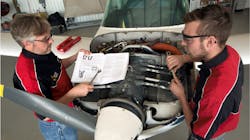Industry Building Momentum to Eliminate Aviation Maintenance Technician Gap
Industry is making measurable progress developing a sufficient, sustainable pipeline of aviation maintenance technicians (AMTs), but clear opportunities remain that can increase momentum, led by filling available slots in technical schools, a new report on AMT career development finds.
The report was developed from data collected by Aviation Technician Education Council (ATEC) and includes findings from a broad survey of accredited aviation maintenance technician schools (AMTS). The data was compiled and analyzed before the novel coronavirus pandemic triggered a significant decline in commercial air transport. While the near- and medium- term implications of airline capacity cuts on maintenance demand remains unclear, demand projections made as of February suggest that industry must focus on continuing to fill the skilled-worker pipeline to meet the long-term need for technicians.
The report’s analysis shows that the 7,363 airframe and powerplant (A&P) certificates issued by the U.S. FAA in 2019 were nearly 10 percent more than in 2018, and the most in 17 years. The industry is attracting more prospective aviation mechanics as well: A&P school enrollments grew by 2 percent in 2019, the biggest annual jump in five years.
These clear positives show that extensive industry efforts to develop more certified aviation mechanics is paying off, but more needs to be done. Mechanics are still retiring faster than they are being replaced. Industry will need to increase its annual figure of new mechanics by 37 percent relative to 2019’s figure to meet the projected 20-year demand.
One place to start: filling more slots at technical schools. Despite the uptick in mechanic certifications and A&P program enrollments, two out of every five A&P program seats remain open.
"The report reflects the shortage of skilled workers in aviation and shows that we were just starting to see some positive, longer-term trends developing,” said Crystal Maguire, ATEC’s executive director. “We have been working hard to get this pipeline in the direction it’s going, and this is the first report indicating that many of the things we are doing are taking hold. We can’t forget that there was a shortage prior to the COVID-19 outbreak, and we can’t lose the people we’ve worked hard to get in the pipeline.”
The report’s other key findings provide more details on the challenge facing industry as more mechanics near retirement, while highlighting opportunities to ensure enough new entrants are coming online to replace them and meet anticipated additional needs. Among them:
- New mechanics make up 2 percent of the population annually, while 33 percent of the workforce is at or near retirement age. Industry will need to produce another 2,700 mechanics annually over its 2019 output to meet the 20-year demand.
- More students are choosing careers in aviation. AMTS respondents estimate that only 8 percent graduates took jobs outside aviation, down from 13 percent in 2017 and 20 percent in 2016.
- For the second consecutive year, AMTS respondents cited the inability to hire and retain qualified faculty as their largest challenge. Also figuring prominently: a perceived lack of aviation career awareness among prospective students.
- The return on investment that students make in A&P programs is high. The average A&P student is in school for 21 months and pays $16,321 in tuition. The average starting annual pay for a certificated mechanic is $45,000.
The report’s findings suggest that one fruitful strategy will be increasing efforts to highlight aviation technical careers. While the awareness issue was cited by schools of various sizes, smaller schools—which make up the majority of AMTS—are less likely to implement their own marketing campaigns to sell aviation technical programs and post-graduation career opportunities.
